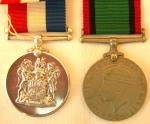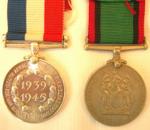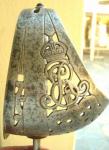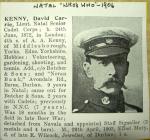-
Posts
13,225 -
Joined
-
Last visited
-
Days Won
22
Content Type
Profiles
Forums
Blogs
Gallery
Events
Store
Everything posted by Mervyn Mitton
-
These are an interesting pair of medals - and not often seen outside of Southern Africa. Left : S.A. Medal For War Service. Introduced in 1946 for service 1939-46, it is made of sterling silver. Both men and women were eligible and to qualify you had to have served for a minimum of two years in a Voluntary organisation - in S.A. or, overseas. Service had to be voluntary and unpaid. The medal is bi-lingual - English and Afrikaans. With the many servicemen passing through S.A. there were quite a number given out - I have been told about 30,000. Value - around £50 ($80) Right : Southern Rhodesian War Service Medal. Introduced in 1946 for service 1939-45. Made of cupro-nickel (coin metal). This was given to those who served in the Southern Rhodesian Forces during the War - but were ineligible for one of the Stars or, War Medals. This is a rare medal and not often seen. Value - over £300 ($480) - possibly more. On a side note - very few Countries could afford Silver for War Medals - Sth. Africa and Canada , they were both producers of the metal. But UK, Aust. NZ,India, were all cupro-nickel. Would be interesting to look into this and see which other places used silver. (I'm not talking of Gallantry or, special medals)
-

R.A.F. Badges Booklet
Mervyn Mitton replied to TacHel's topic in Great Britain: Militaria: Badges, Uniforms & Equipment
Frank - go to Google - Cigarette Cards - Values. Many sites, you will need to look for the Company who printed yours and the set name and number. -
Brian - wow ! Indonesian Kris' 101... I am so glad I started this thread with the one small sash kris - we have all learnt a great deal and I hope there will be further posts. I was looking at Hugh's example (no.14) and thinking that the gold coloured markings were possibly the remains of gold leaf - now after your warning , are they rust ? What do you think ?
-
Thought these two items might be of interest to your members. I understand he was a Grand Master. Greytown is inland from Durban in South Africa - about 200 (320kms.) miles from the Coast. A farming area, so draws on quite a large population. I understand that he would have held office in the 1930's. This one is silver gilt - the next one has silver gilt surround and solid gold centre.
-
Amazing that you can still fit ? I'm not sure I would still fit into mine - however, I didn't keep it when they were withdrawn - you will probably know that they were all sold to Elstree Film Studios for £3.50 each - and, the best Melton cloth you could buy. I knew Poplar well we used to go there on Sundays when our canteen at HB was closed. I don't expect you would know it now with all the new Dockland developments. When I was radio operator on Hotel 2 , we used to go down to Isle of Dogs, on night duty, and look at the ships.... Are you retired now - do you still live-in London ?( Just being nosey????) Mervyn
-
That's great Jonathan - so he was trapped in Ladysmith with the Natal Naval Contingent. Would rather have his medals than the sword - a rare unit. Thankyou.
-
Our posts crossed and got jammed-up. Seems to be OK now. That looks to be a nice example and seems old from the patination. The story adds to it's value for you.
-
Yes - Bali has always been special. I used to handle the advtg. for Garuda Airways and have some wonderful Balinese carvings. Your comments re wearing a Kris on special occasions explains the small sash version. When were you in Singapore ? I was in Thailand from 1960 to 64.
-
That would be good. The engraving on your sword is far superior than the Natal sword - in fact, I can't think of a worse example. I am actually wondering if it was an ummarked sword and they got someone here, in Natal, to do the engraving ? The alternative is that he must have been drunk....
-
-
I've just noticed that the horns on the lower wildebeeste have become a tusk !! Must have been an apprentice doing the work ?
-
-
-
-
NNC were the Natal Naval Contingent and had a unit in the Defense of Ladysmith. The write-up mentions two medals and four bars. Obviously QSA and KSA - perhaps Def. of Ladysmith ? p.s. Fancy putting 'Volunteering' as a hobby. We had a name for that when I was at school !!!
-
Interesting example of an infantry officers' sword - Boer War period. Has a lot of inscriptions engraved on the blade - including the owner's name. We were lucky enough to find ref. to him in the 1906 Natal Who's Who - a rare book in it's own right - it was the only issue for that period and lists many of the early settlers. Edward 7th. swords are always sought after - being a short reign there are not that many of them. The other rare thing is that the Natal arms of two running Wildebeeste (knu) are shown .The sword is by Hobson - a swordmaker on par with Wilkinson. However, for a special commission I can't say that the engraving is particularly well done - perhaps they were working to a budget ? What do you think Jonathen ?
-
Brian - I'm so glad you found that book !! Does it give a reason for the notch ? Now that we know it represents an elephant head - you can see the shape. The kris you illustrate - could you do a picture - it looks to have age ? Of course some Kris' are extremely valuable - they use a process of folding the hot metal - same as top european swordsmiths (the name escapes me at this moment) and it can take months of work. Thankyou for finding this ref. - we have all learnt something.
-

Zulu items
Mervyn Mitton replied to helen's topic in Great Britain: Militaria: Badges, Uniforms & Equipment
There is so much to show in Zulu artefacts and culture, that I think it worthwhile adding the occasional post to this thread. The item shown here is a traditional DAGGA pipe ( marijuana) used mainly by a group of senior chiefs sitting in the kraal. Dagga grows freely in Sth. Africa and can be a problem - the police use helicopters and small planes to set fire to the hidden fields or, drop pesticide. A large proportion of the drug sold in Europe, probably originates here - and much of it from KwaZulu Natal. The main body of the pipe is an antelope horn - from a Nyala. They are strange in that the female is a light tan colour and not very big - but the male , is much larger and a grey colour with white stripes - almost a different species. The dagga is put in the mouth of the horn and inhaled through the mouth pipe, which is put in the horn through a hole. The shaft is wood, but the mouth piece is carved from stone.The pipe would be passed around the gathering - however, if the owner wanted to smoke on his own, he would put the leaf in the stone part and inhale through the end of the shaft. This example probably dates back well over a hundred years. You can always tell users - 'dopey' looking with red eyes ! And it can often be smelt from people sitting on benches in the street... -
Stuart - this information and detail is what a forum is all about - not just the pictures - but also, the reason for changes and progress. I had no idea that we had ever tried a Polish Lancer unit - they were always regarded as the greatest horse cavalry in Europe and were responsible for turning the Turks back at the gates of Vienna. They used large horse axes as well as sword and lances and were greatly feared. What a pity the British didn't persist with them. Thankyou for doing this research - particularly on the changes and amalgamations with regiments. We could really expand this thread by looking at the individual campaigns of each regt.. I will volunteer (better than a 'pressed' man ! ) to research the 17th Lancers in the 1879 Zulu War. They were the only cavalry unit - apart from Gen. Chelmsford's mounted guard of a squadron of 1st. Royal Dragoon Guards. Any other members willing to pick a subject to investigate ?
-

QUEEN and KING SOUTH AFRICA MEDALS
Mervyn Mitton replied to a topic in Great Britain: Orders, Gallantry, Campaign Medals
Eitze. Just a few details for your Steinacker's Horse QSA - although I think you said you no longer have it ? They were raised in June 1900 by Lt.Col.F. von Steinacker. They served in the Northern Transvaal and were disbanded in 1902. They had a strength of 450 men and , I understand, sent a contingent to King Edward 7th.s Coronation.














